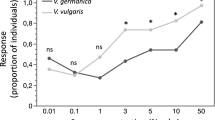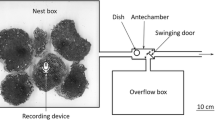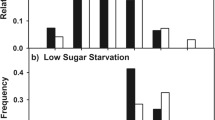Abstract
Social wasps do not possess a sophisticated, signal-based mechanism for recruiting foragers to food resources. Instead, in some species naïve potential foragers use cues, specifically the scent of a resource obtained from successful foragers, to help locate the resource in the field. Prior studies have focused on the effectiveness of this mechanism on increasing the number of foragers at an artificial resource in the field; the increase is typically modest. Here, we focus on the activity at the nest in Polybia occidentalis, a tropical social wasp, and quantify the magnitude of the effect an influx of a known amount of scented carbohydrate solution added directly to the nest has on activating foragers to leave the nest in search of the resource. Under our experimental conditions, adding a scented 2.0 M sucrose solution to the nest doubled the average rate of departure. No increase occurred when the same amount of water was added as a control. This mass activation of foragers may give colonies of this species a competitive edge by enhancing their ability to rapidly exploit new resources.

Similar content being viewed by others
References
Akaike H. 1974. A new look at statistical model identification. IEEE Trans. Autom. Control 19: 716-723.
Beekman M. 2005. How long will honey bees (Apis mellifera L.) be stimulated by scent to revisit past-profitable forage sites? J. Comp. Physiol. A 191: 1115-1120.
Biesmeijer J.C. and Tóth E. 1998. Individual foraging, activity level and longevity in the stingless bee Melipona beecheii in Costa Rica (Hymenoptera, Apidae, Meliponinae). Insect. Soc. 45: 427-443.
Blatt J. and Roces F. 2001. Haemolymph sugar levels in foraging honeybees (Apis mellifera carnica): dependence on metabolic rate and in vivo measurement of maximal rates of trehalose synthesis. J. Exp. Biol. 204: 2709-2716.
Blatt J. and Roces F. 2002. The control of the proventriculus in the honeybee (Apis mellifera carnica L.) I. A dynamic process influenced by food quality and quantity? J. Insect Physiol. 48: 643-654.
Bouwma A.M., Bouwma P.E., Nordheim E.V. and Jeanne R.L. 2003. Adult mortality rates in young colonies of a swarm-founding wasp (Polybia occidentalis). J. Zool. 260: 11-16.
Candy D.J. 1989. Utilization of fuels by the flight muscle. In: Insect Flight (Goldsworthy G.J. and Wheeler C.H., Eds), CRC Press, Boca Raton, FL, USA. pp 305-319.
Carmer S.G. and Swanson M.R. 1973. An evaluation of 10 pairwise multiple-comparison procedures by Monte Carlo methods. J. Amer. Statistical Assoc. 68: 66-74.
Crailsheim K. 1988a. Regulation of food passage in the intestine of the honeybee (Apis mellifera L.). J. Insect Physiol. 34: 85-90.
Crailsheim K. 1988b. Intestinal transport of sugars in the honeybee (Apis mellifera L.). J. Insect Physiol. 34: 839-845.
Dornhaus A. and Chittka L. 1999. Evolutionary origins of bee dances. Nature 401: 38.
Dornhaus A. and Chittka L. 2001. Food alert in bumblebees (Bombus terrestris): possible mechanisms and evolutionary implications. Behav. Ecol. Sociobiol. 50: 570-576.
Dornhaus A. and Chittka L. 2005. Bumble bees (Bombus terrestris) store both food and information in honeypots. Behav. Ecol. 16: 661-666.
Dornhaus A., Brockmann A. and Chittka L. 2003. Bumble bees alert to food with pheromone from tergal gland. J. Comp. Physiol. A 189: 47-51.
Edwards R. 1980. Social Wasps: Their Biology and Control. Rentokil Limited, Sussex, UK.
Farina W.M., Grüter C., Acosta L. and McCabe S. 2007. Honeybees learn floral odors while receiving nectar from foragers within the hive. Naturwissenschaften 94: 55-60.
Forsyth A.B. 1978. Studies on the behavioral ecology of polygynous social wasps. PhD dissertation, Harvard University, Cambridge, Mass, USA.
von Frisch K. 1967. The Dance Language and Orientation of Bees. The Belknap Press of Harvard University Press, Cambridge, Mass, USA.
Hocking B. 1953. The intrinsic range and speed of flight of insects. Trans. R. Entomol. Soc. Lond. 104: 223-345.
Hölldobler B. and Wilson E.O. 1990. The Ants. Belknap Press of Harvard University Press, Cambridge, Mass, USA.
Hrncir M. 2009. Mobilizing the foraging force: mechanical signals in stingless bee recruitment. In: Food Exploitation by Social Insects: Ecological, Behavioral, and Theoretical Approaches (Jarau S. and Hrncir M., Eds), CRC Press, Boca Raton, FL, USA, pp 199-221.
Hrncir M., Mateus S. and Nascimento F.S. 2007. Exploitation of carbohydrate food sources in Polybia occidentalis: social cues influence foraging decisions in swarm-founding wasps. Behav. Ecol. Sociobiol. 61: 975-983.
Hunt J.H., Jeanne R.L., Baker I. and Grogan D.E. 1987. Nutrient dynamics of a swarm-founding social wasp species, Polybia occidentalis (Hymenoptera: Vespidae). Ethology 75: 291-305.
Hunt J.H., Rossi A.M., Holmberg N.J., Smith S.R. and Sherman W.R. 1998. Nutrients in social wasp (Hymenoptera: Vespidae, Polistinae) honey. Ann. Entomol. Soc. Am. 91: 466-472.
Jandt J.M. and Jeanne R.L. 2005. German yellowjacket (Vespula germanica) foragers use odors inside the nest to find carbohydrate food sources. Ethology 111: 641-651.
Jarau S. 2009. Chemical communication during food exploitation in stingless bees. In: Food Exploitation by Social Insects: Ecological, Behavioral, and Theoretical Approaches (Jarau S. and Hrncir M., Eds), CRC Press, Boca Raton, FL, USA, pp 223-249.
Jarau S. and Hrncir M. (Eds) 2009. Food Exploitation by Social Insects: Ecological, Behavioral, and Theoretical Approaches, CRC Press, Boca Raton, FL, USA.
Jeanne R.L. 1981. Alarm recruitment, attack behavior, and the role of the alarm pheromone in Polybia occidentalis (Hymenoptera: Vespidae). Behav. Ecol. Sociobiol. 9: 143-148.
Jeanne R.L. 1986. The organization of work in Polybia occidentalis: costs and benefits of specialization in a social wasp. Behav. Ecol. Sociobiol. 19: 333-341.
Jeanne R.L. 1991. The swarm-founding Polistinae. In: The Social Biology of Wasps (Ross K.G. and Matthews R.W., Eds), Cornell University Press, Ithaca, NY, USA, pp 191-231.
Jeanne R.L. and Taylor B.J. 2009. Individual and social foraging in social wasps. In: Food Exploitation by Social Insects: Ecological, Behavioral, and Theoretical Approaches (Jarau S. and Hrncir M., Eds), CRC Press, Boca Raton, FL, USA, pp 53-79.
Jeanne R.L., Hunt J.M. and Keeping M.G. 1995. Foraging in social wasps: Agelaia lacks recruitment to food (Hymenoptera: Vespidae). J. Kans. Entomol. Soc. 68: 279-289.
Kammer A.E. and Heinrich B. 1974. Metabolic rates related to muscle activity in bumblebees. J. Exp. Biol. 61: 219-227.
Kenward M.G. and Roger J.H. 1997. Small sample inference for fixed effects from restricted maximum likelihood. Biometrics 53: 983-997.
Maschwitz U., Beier W., Dietrich I. and Keidel W. 1974. Futterverständigung bei Wespen der Gattung Paravespula. Naturwissenschaften 61: 506.
Michener C.D. 1974. The Social Behavior of the Bees. The Belknap Press of Harvard University Press, Cambridge, Mass, USA.
Molet M., Chittka L., Stelzer R.J., Streit S. and Raine N.E. 2008. Colony nutritional status modulates worker responses to foraging recruitment pheromone in the bumblebee Bombus terrestris. Behav. Ecol. Sociobiol. 62: 1919-1926.
Molet M., Chittka L. and Raine N.E. 2009. How floral odours are learned inside the bumblebee (Bombus terrestris) nest. Naturwissenschaften 96: 213-219.
Naumann M.G. 1970. The nesting behavior of Protopolybia pumila in Panama (Hymenoptera, Vespidae). PhD dissertation, The University of Kansas, Lawrence, KS, USA.
Nieh J.C. 2004. Recruitment communication in stingless bees (Hymenoptera, Apidae, Meliponini). Apidologie 35: 159-182.
O’Donnell S. and Jeanne R.L. 1992. Lifelong patterns of forager behavior in a tropical swarm-founding wasp: effects of specialization and activity on longevity. Anim. Behav. 44: 1021-1027.
Overmyer S.L. and Jeanne R.L. 1998. Recruitment to food by the German yellowjacket, Vespula germanica. Behav. Ecol. Sociobiol. 42: 17-21.
Padilla M.A. and Algina J. 2004. Type I error rates for a one factor within-subjects design with missing values. J. Mod. Appl. Stat. Methods 3: 406-416.
Reinhard J., Srinivasan M.V., Guez D. and Zhang S.W. 2004. Floral scents induce recall of navigational and visual memories in honeybees. J. Exp. Biol. 207: 4371-4381.
Richards O.W. 1971. The biology of the social wasps (Hymenoptera, Vespidae). Biol. Rev. 46: 483-528.
Roces F. and Blatt J. 1999. Haemolymph sugars and the control of the proventriculus in the honey bee Apis mellifera. J. Insect Physiol. 45: 221-229.
Schmid-Hempel P. and Schmid-Hempel R. 1984. Life duration and turnover of foragers in the ant Cataglyphis bicolor (Hymenoptera, Formicidae). Insect. Soc. 31: 345-360.
Schmid-Hempel P. and Wolf T. 1988. Foraging effort and life span of workers in a social insect. J. Anim. Ecol. 57: 500-521.
Schueller T.I., Nordheim E.V., Taylor B.J. and Jeanne R.L. 2010. The cues have it; nest-based, cue-mediated recruitment to carbohydrate resources in a swarm-founding social wasp. Naturwissenschaften 97: 1017-1022.
Sonnentag P.J. and Jeanne R.L. 2009. Initiation of absconding-swarm emigration in the social wasp Polybia occidentalis. J. Insect Sci. 9(11): 11 pp.
Spilke J., Piepho H.-P. and Hu X. 2005. A simulation study on tests of hypotheses and confidence intervals for fixed effects in mixed models for blocked experiments with missing data. J. Agr. Biol. Envir. S. 10: 374-389.
Spradbery P.J. 1973. Wasps: An Account of the Biology and Natural History of Solitary and Social Wasps. University of Washington Press, Seattle, WA, USA.
Taylor B.J., Schalk D.R. and Jeanne R.L. 2010. Yellowjackets use nest-based cues to differentially exploit higher-quality resources. Naturwissenschaften 97: 1041-1046.
Taylor B.J., Nordheim E.V, Schueller T.I. and Jeanne R.L. 2011. Recruitment in swarm-founding wasps: Polybia occidentalis does not actively scent-mark carbohydrate food sources. Psyche 2011: 7 pp.
Wheeler C.H. 1989. Mobilization and transport of fuels to the flight muscle. In: Insect Flight (Goldsworthy G.J. and Wheeler C.H., Eds), CRC Press, Boca Raton, FL, USA, pp 273-303.
Wilson E.O. 1971. The Insect Societies. The Belknap Press of Harvard University Press, Cambridge, Mass, USA.
Woodring J., Boulden M., Das S. and Gäde G. 1993. Studies on blood sugar homeostasis in the honeybee (Apis mellifera, L.). J. Insect Physiol. 39: 89-97.
Acknowledgments
We are pleased to give our sincere thanks to the Hagnauer family and the Centro Rescate Las Pumas for allowing us to collect nests and perform research on their land. We also extend thanks to Luis Alonso Moncada Duran and Teresa Schueller, who helped with nest collection. Teresa Schueller also provided thoughtful comments to improve the manuscript. We are grateful to Erik Nordheim and Peter Crump for help with statistical analyses. Research was supported by the College of Agricultural and Life Sciences, University of Wisconsin-Madison.
Author information
Authors and Affiliations
Corresponding author
Rights and permissions
About this article
Cite this article
Taylor, B.J., Brus, E.J. & Jeanne, R.L. Introduction of a scented carbohydrate resource into the nest increases departure rate in Polybia occidentalis . Insect. Soc. 59, 151–157 (2012). https://doi.org/10.1007/s00040-011-0200-z
Received:
Revised:
Accepted:
Published:
Issue Date:
DOI: https://doi.org/10.1007/s00040-011-0200-z




